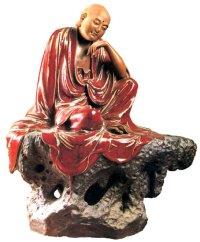RAHULA
Contents
. Birth and Early Life
. Rahula’s Education
. Enlightenment and Sutras
. Past Lives
. Passing Away
. Conclusion
Birth and Early Life
 Rahula was the son of Buddha and was one of his close disciples. It is said that Prince Siddhartha was already disturbed by the illusory nature of life and at the time he left home in search of Truth his wife Yashodhara had given birth to a son. It is stated that he was named Rahula meaning fetters as Siddhartha felt the birth of a child to be a further bondage to him. It is likely that he was named after Rahu(a lunar eclipse) which might have occurred at the time of his birth. Many years after he attained enlightenment the Buddha returned to Kapilvasthu. When Buddha was preaching Yashodhara took Rahula and pointing out to the Buddha as his father instructed him to go and ask his father for his share of inheritance. When Rahula did so the Buddha asked his chief disciple Sariputta to ordain him. Buddha knew that inheritance of wealth and land would hold no good for after life and only the attainment of Nirvana would help Rahula gain freedom from the infinite cycles of birth and death and give infinite happiness.
Rahula was the son of Buddha and was one of his close disciples. It is said that Prince Siddhartha was already disturbed by the illusory nature of life and at the time he left home in search of Truth his wife Yashodhara had given birth to a son. It is stated that he was named Rahula meaning fetters as Siddhartha felt the birth of a child to be a further bondage to him. It is likely that he was named after Rahu(a lunar eclipse) which might have occurred at the time of his birth. Many years after he attained enlightenment the Buddha returned to Kapilvasthu. When Buddha was preaching Yashodhara took Rahula and pointing out to the Buddha as his father instructed him to go and ask his father for his share of inheritance. When Rahula did so the Buddha asked his chief disciple Sariputta to ordain him. Buddha knew that inheritance of wealth and land would hold no good for after life and only the attainment of Nirvana would help Rahula gain freedom from the infinite cycles of birth and death and give infinite happiness.
Rahula’s education
Buddha took great interest in Rahula’s moral and spiritual education. Sariputta became his preceptor and Moggallana his teacher. It is said that even though he was only seven years old when he became a novice monk he was eager to obey the instructions taught to him. The Buddha taught him to reflect and think before he acted to ensure that his actions were moral and conducive to the well being of others. Thus the Buddha introduced Rahula to mindfulness and the methods to keep the mind and thoughts pure. It is said that Rahula was so sincere that every morning he would take a handful of sand and pray that he would learn as many words of counsel as the grains of sand.
Enlightenment and Suttas or Sutras
After his acceptance as a novice monk, Buddha taught him the importance of speaking the truth. This discourse is known as Ambalatthika Rahulovada Sutta. He explained with simple examples that the precept of truth was the most important precept. Two other Rahulovada Suttas one included in the Samyutta and the other in the Anguttara form the topics for Rahula’s Vipassana meditation. Later when Rahula’s mind was ripe for final attainment the Buddha went to him and preached the Cula Rahulovada Sutta. At the end of the discourse Rahula became an Arahant. The eighteenth section of the Samyutta Nikaya consists of a series of discourses given to Rahula by the Buddha preached on various occasions from the time he entered the order to his Arahantship about the fleeting nature of all things, association with the holy etc.
Past Lives
The Buddha stated that Rahula had been closely associated with him even in earlier lives and had always been a model of sincerity and discipline. He is mentioned in the Jataka tales associated with the Buddha as Bodhisattva. Even in the present life he was well known for his obedience and truthfulness.
Passing Away
According to the Samyutta and Digha Commentaries Rahula is said to have predeceased the Buddha and the two disciples Sariputta and Moggalana and the place of his death is given as Tavatimsa. Emperor Ashoka is said to have built a Stupa in honour of Rahula to be specially worshipped by novices.
Conclusion
His pleasing and obedient nature along with his young age made Rahula a role model for all the monks especially the younger and novice monks. Many instances in the scriptures illustrated Rahula’s extreme conscientiousness in the observance of rules. The greatness of Rahula was that inspite of the Buddha being his father and his joining at a tender age, his maturity and sincerity to the teachings resulted in success in his search for truth.
- Wikipedia.com
- Buddhanet.net
- Buddhism.about.com
- Palikanon.com
- budsas.org
- enquarterly.tzuchiculture.org.tw
- buddhismnow.com
